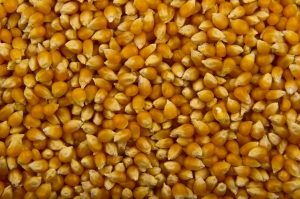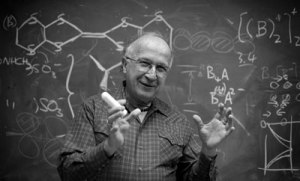The Pressure of Popping Corn
 Essential Question: How do the gas laws, in combination with the structure of popcorn, explain popcorn’s “popping” when heated?
Essential Question: How do the gas laws, in combination with the structure of popcorn, explain popcorn’s “popping” when heated?
Popping popcorn involves heating the kernel until it is so hot that it causes the inside of the kernel to release moisture and pop inside out. The ideal gas law is used in this experiment. The ideal gas law relates the variables of pressure, volume, temperature, and number of moles of gas within a closed system.
The ideal gas law takes the form:
PV = nRT
P = Pressure of the confined gas in atmospheres
V = Volume of the confined gas, in liters
n = Number of moles of gas
R = Gas Constant, 0.0821 L·atm/mol·K
T = Temperature in Kelvin
Recorded Lab Results:
Brand A
Average mass kernal popped- .62 g
Average mass popped kernal- .66 g
Mass H20- .4 g
Brand B
Average mass kernal popped- .64 g
Average mass popped kernal- .69 g
Mass H20- .5 g
D= m/v
PV= nRT
n= moles H20
T= 225 degrees celsius
H20= 1 g/mL
v= .4
The process of popping popcorn is not that complex. When you heat popcorn kernals the moisture from inside the kernel becomes so hot that it needs to be released and when it is released the kernal flips inside out. Some kernels do not pop because popcorn kernels contain an optimal hull structure that allow the kernel to explode. The leaky hulls prevent the moisture pressure buildup needed for the kernels to pop. The relationship between pressure and temperature the ideal gas law. As the pressure goes up so does the temperature, and vice-versa. As the temperature of the popcorn goes up the pressure increases.
I used to think… Now I think…
 I used to think that gases were just what we breathe in. I used to think that we didnt really know much about what they are affected by. I now think that gases are affected by heat and temperature.
I used to think that gases were just what we breathe in. I used to think that we didnt really know much about what they are affected by. I now think that gases are affected by heat and temperature.
The Poetry of Chemistry
Chemistry is substances, molecules and their transformations
Each substance faces categorization
Chemicals face the different reactions
Combustion, decomposition,
Both of those happen
Chemistry and science are an important part of our world
More knowledge is waiting to be uncurled
Law of Conservation Mass Lab

Nicolette Kent
Class D
January 10th, 2012
Activity 1: When adding the lead nitrate and the potassium iodide together it turned yellow
Weight before- .553
Weight after- .599
Change in mass= .046
A chemical reaction occured and the sodium iodide reacted when the lead nitrate was added. The change did affect the mass because another solution was added.
Activity 2: We combined baking soda and vinegar in a plastic bag and watched the baking soda react with the vinegar. The plastic bag filled up with CO2 and got bigger.
CO2 is formed when combining baking soda and vinegar.
Activity 3: We placed steel wool over the Bunsen burner and it changed colors (blue, purple, and brown).
Dish before- 40.235
Wool before- 0.8
Weight after- 43.01
Change in mass= 0.81
The Law of Conservation of Mass: a relation stating that in a chemical reaction, the mass of the products equals the mass of the reactants.
In this lab I learned that some things are changed in their appearance and their mass changes, other things are changed in their appearance and their mass does not change at all. I also learned that the Law of Conservation of Mass is a relation stating that in a chemical reaction, the mass of the products equals the mass of the reactants.
Question from Activity 1: What do you think happened when you mixed the solutions? Did the change you observed affect the mass?
Answer: The two solutions reacted together and changed the substance. Yes the change affected the mass.
Question from Activity 2: What happened when the vinegar and baking soda were combined? Did this change result in a change in mass in the open flask? Did this change result in a change in mass in the closed flask? How could you account for both of these?
Answer: When the vinegar and baking soda were combined they reacted with each other and a new substance was created and that new substance expanded the plastic bag and created more air in the plastic bag. This change resulted in a change in mass in the open flask because it let the air out. In the closed flask there wouldnt be any air let out. You could account for both of these by measuring their masses.
Question from Activity 3: How did heating the steel wool affect its appearance? Did this change result in a change in mass? How could you account for this?
Answer: Heating the steel wool caused it to change color, to a blue, purple, and brown color. This change did not result in a change in mass.
How do we know what we know about the Building Blocks of matter?
The things we learn about today in class are proven theories and facts provided to us by previous scientists. These things we learn are communicated to us from these scientists and passed on to us from generations. The building blocks of matter make up our world today and help us know many things. Many other discoveries help us with studies today. Avogadro’s number helps scientists and others in the field of chemistry solve many problems. Avogadro’s number also helps scientists to have a common number between each other, and communicate accurately. The electron configuration affects the behavior of an element by giving off wave length. Another way is the Octet Rule when it wants 8 electrons in its outermost energy level.
Life as a Scientist
Hello World! I am a student taking 10th grade Chemistry. I enjoy science and like learning new things. I am always interested in the possibilities of our world. I also enjoy working with hands on things such as labs in the classroom. I also like working with others during these labs because that teaches us how to work with others. I am intrigued by the connections science and every day life. I look forward to the new things we will be learning in Chemistry this year.




